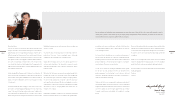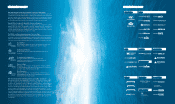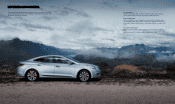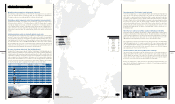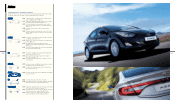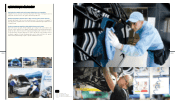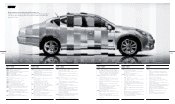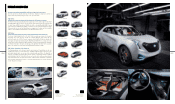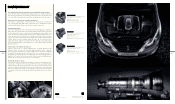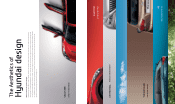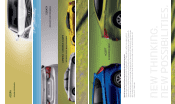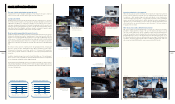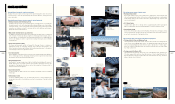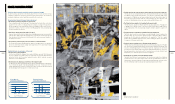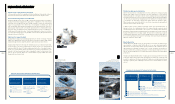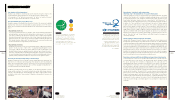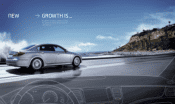Hyundai 2010 Annual Report Download - page 19
Download and view the complete annual report
Please find page 19 of the 2010 Hyundai annual report below. You can navigate through the pages in the report by either clicking on the pages listed below, or by using the keyword search tool below to find specific information within the annual report.
New and innovative technology presents a new standard for superior vehicles
Just as the future requires stepping beyond yesterday’s bounds, now Hyundai is being reborn
with technology that eliminates the old barriers around the automobile. Hyundai stands at the
very center of the cutting-edge technologies that are moving the global automotive market.
Power train: A strong heart and a sensitive transmission
From compacts to passenger and commercial vehicles, the power train center is the heart of
every car. With independently made engines, transmissions and eco-friendly exhaust systems
are developed by Hyundai, and are recognized as the strongest in their class.
Inimitable performance
The history of Hyundai’s automotive engines began in 1991 with the Alpha engine, marking the
birth of independent Korean automotive technology. In 2004, Hyundai’s Zeta engine became
the rst exported from Korea to a developed country, displaying the technical ability of the
Korean auto industry and raising Hyundai’s brand recognition. In 2009, the R passenger diesel
engine was developed, which was met Euro-5 regulations and classied as a low-emission
engine for the Seoul metropolitan region. The Tau engine has received the “Ward’s Top 10 Best
Engines” award, known as the Academy Awards for engines, for three straight years from
2008 to 2010. In 2010, with the development of the Theta GDi engine, which improved fuel
economy and had the highest motor performance in its class, Hyundai’s engine technology
again raised the bar.
Development of eco-friendly transmissions
Hyundai is doing its utmost to develop high-performance eco-friendly transmissions that
implement diverse customer needs to lead the global transmission market. In particular,
with the successful development of the six-speed 2WD automatic transmission in 2009 and
the hybrid CVT (continuously variable transmission) for LPi use, we have achieved a level of
cutting-edge technology that places us in a leading position on the international market. In
addition, in 2011 we were the rst automotive rm to debut an eight-speed RWD automatic
transmission, thus boasting the world’s top level of technical ability.
Eco-friendly emissions system
The power train center is accelerating the development of power trains for hybrid vehicles. It
is also working on improved motor efciency and low-friction technology, along with reduced-
weight methods to improve fuel efciency and minimize air pollution due to automotive gas
emissions. In addition, a highly-efcient emissions gas cleaning system is being developed
that reduces harmful gases emitted from the low-pollution engine, which not only responds
to increasing restrictions on emissions but also leads the way in the production of eco-friendly
vehicles.
Year of rst large-scale mass production: 2009
Used in model: Sonata, Santa Fe
Capacity (L): 2.0 / 2.4
Maximum power (ps) 165 / 178
Maximum rotation speed (kg·m) 20.2 / 23.3
Year of rst large-scale mass production: 2008
Used in model: Genesis, Centennial
Capacity (L): 3.3 / 3.8 / 4.6 / 5.0
Maximum power (ps) 262 / 290
Maximum rotation speed (kg·m) 32.2 / 36.5
Year of rst large-scale mass production: 2009
Used in model: Santa Fe , Tucson
Capacity (L): 2.0 / 2.2
Maximum power (ps) 177 / 197
Maximum rotation speed (kg·m) 40.0 / 44.5
1 Dual-CVVT
2 RWD six-speed auto transmission
Genesis equipped with TAU 5.0 engine 1
RWD eight-speed auto transmission 2


